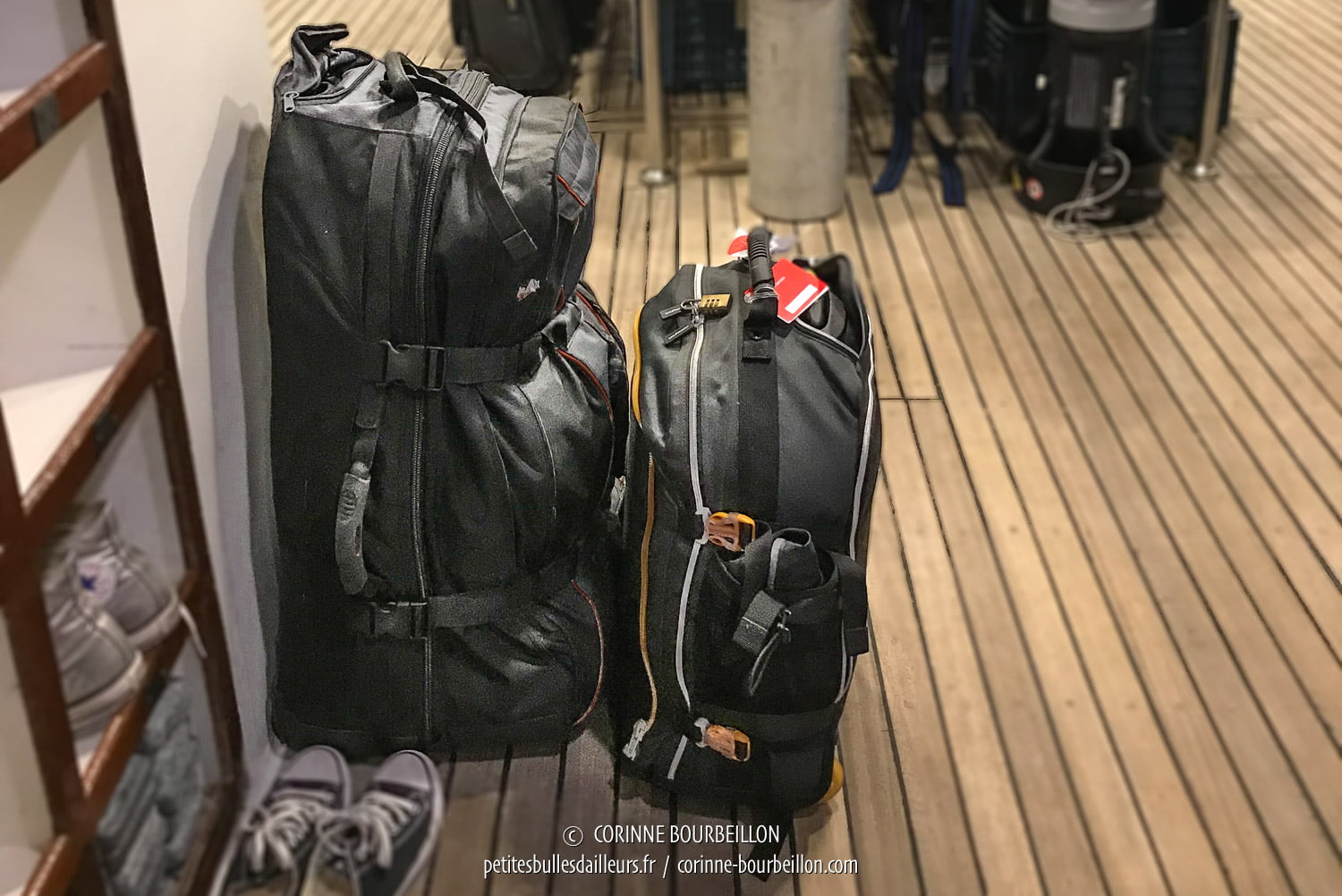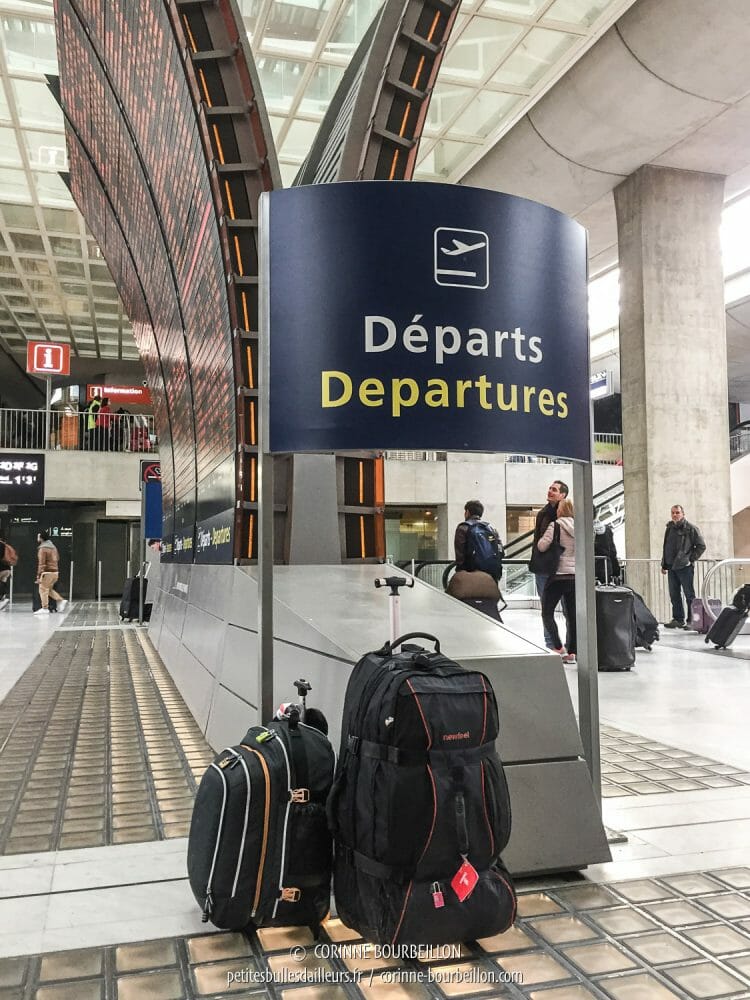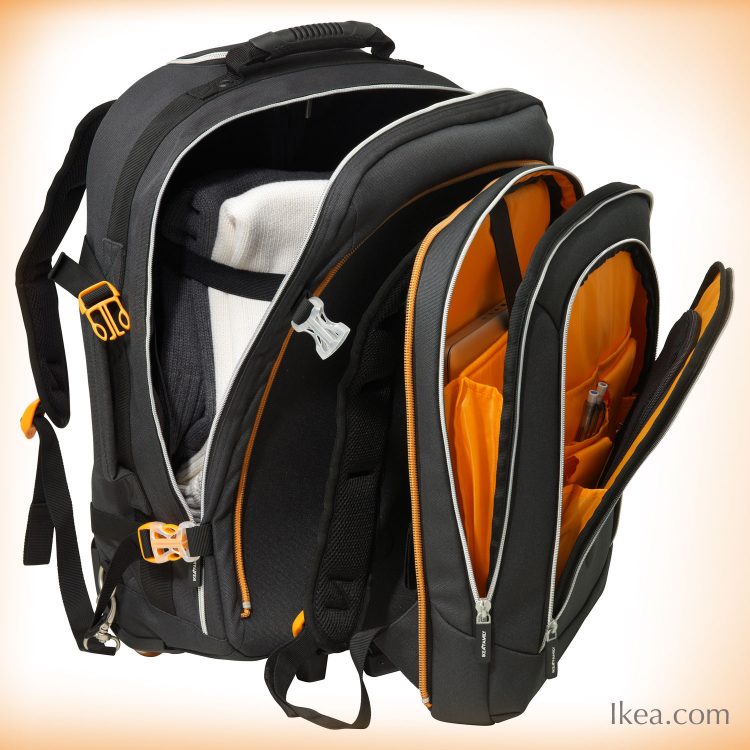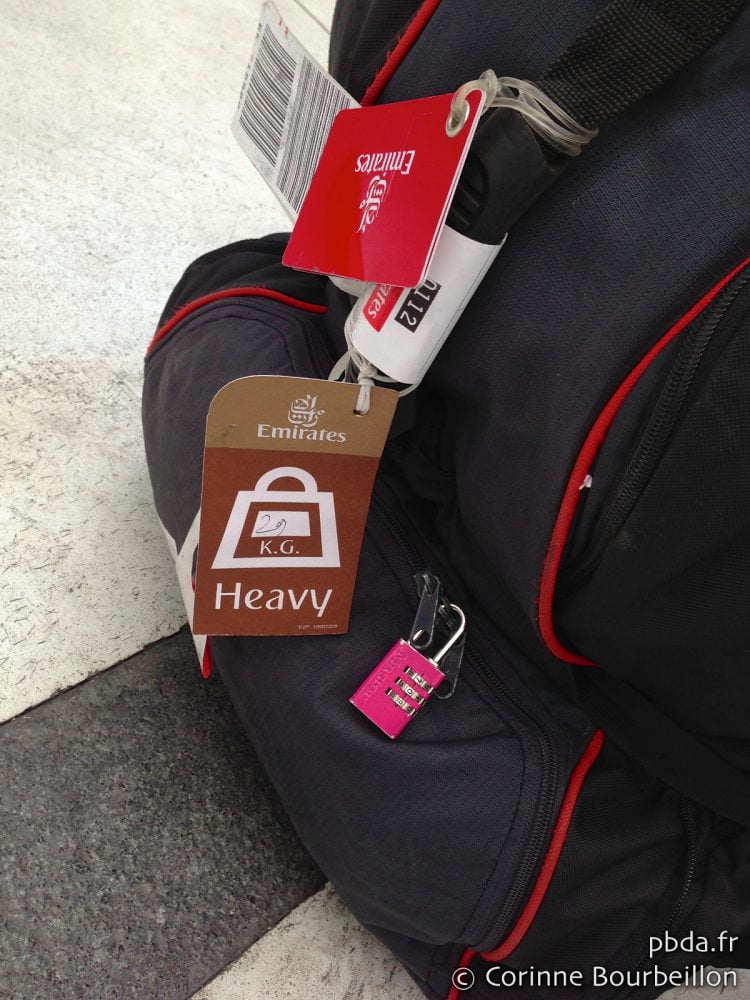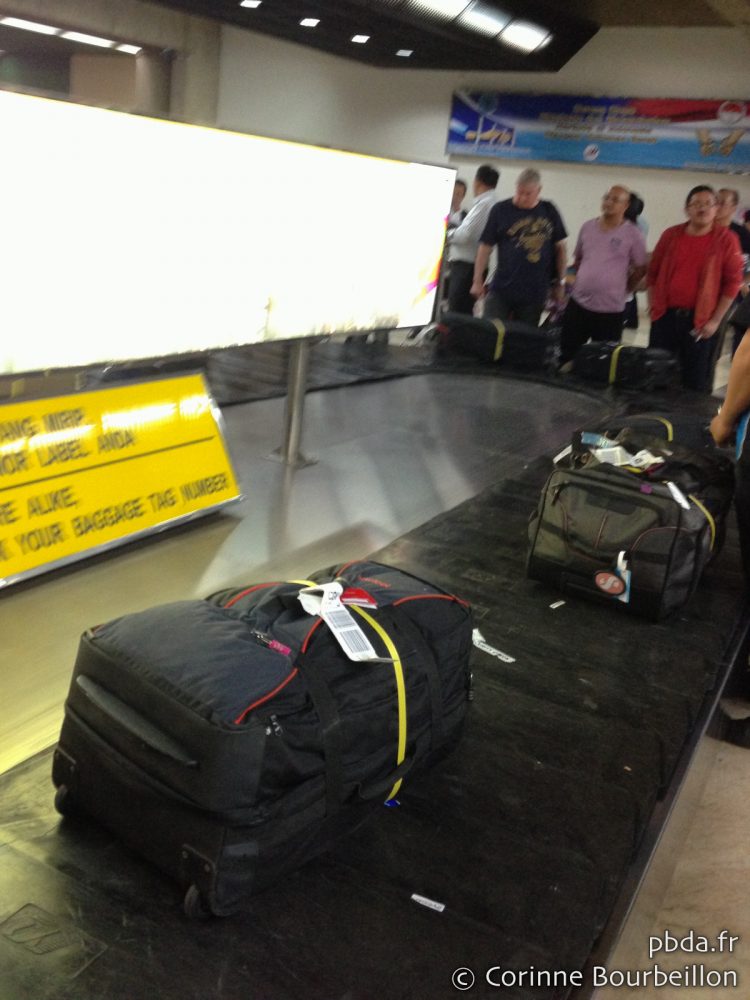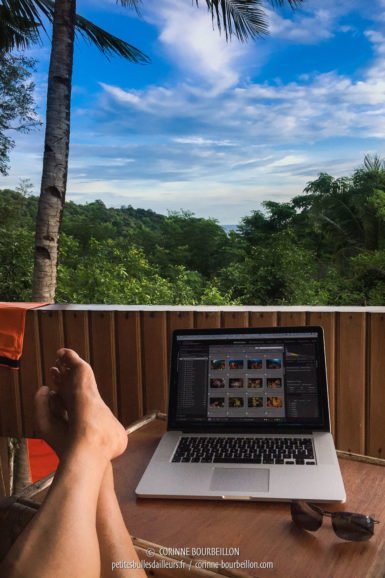Dear English-speaking readers, this page is an automatic translation of an article originally written in French. I apologise for any strange sentences and funny mistakes that may have resulted. If you read French, click on the French flag below to access the original, correct text:
My diving equipment and underwater photography gear now take up the lion's share of my luggage. Impossible for me to travel light as before! But the basic principle remains valid: I must be able to carry my dive bag and all my stuff on my own.
Disclaimer : this is NOT a sponsored article, I am not affiliated with ANY of the brands I mention below in this article. I have been investing little by little, year after year, especially in computer, photographic and diving equipment...
My diving travel bag since July 2018
I invested in a new rolling bag in 2018 to replace the previous one (see below). I wanted it to be designed in the same way:
- a bag large enough to hold my diving equipment, clothes and accessories for underwater photography;
- and opens in two compartments, like a wallet. Practical to separate the diving gear from the rest.
Again, I opted for a discreet bag, with no brand name written in big letters on it. In my opinion, there is nothing worse than displaying the name or logo of a diving equipment manufacturer on your luggage. It signals that there are valuable things inside, and that you are potentially a (very) rich tourist...
I chose a reliable modelThis is the name of a well-known luggage brand (Eastpack) that guarantees its products for thirty years. Its name : Transver L.
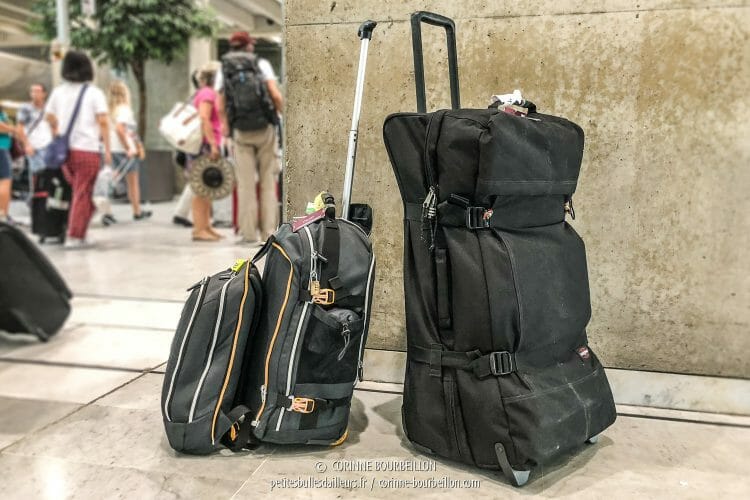
This big Eastpack wheeled bag is less cheap than my previous Decathlon bag, and a bit bigger (121 liters). I hope it will last as long or even longer!
So far, I am very satisfied with it. It is sturdy, handy, practical and does not attract attention.
Underwater photo logistics
I don't carry my stuff in a backpack like when I was 20 years old... I now carry a whole equipment for underwater photography so I had to completely rethink the organization of my luggage!
The solution of the big bag on wheels was quickly obvious.
Because in addition to the SLR camera and its waterproof case that I keep in my small cabin luggage, I have to carry the heavy gear that goes with it: the stage (support) with its two handles, the flashes and their batteries, the arms of the flashes, the charger for these flashes, the cables, etc. I put you some pictures below, to give you an idea of the mess...
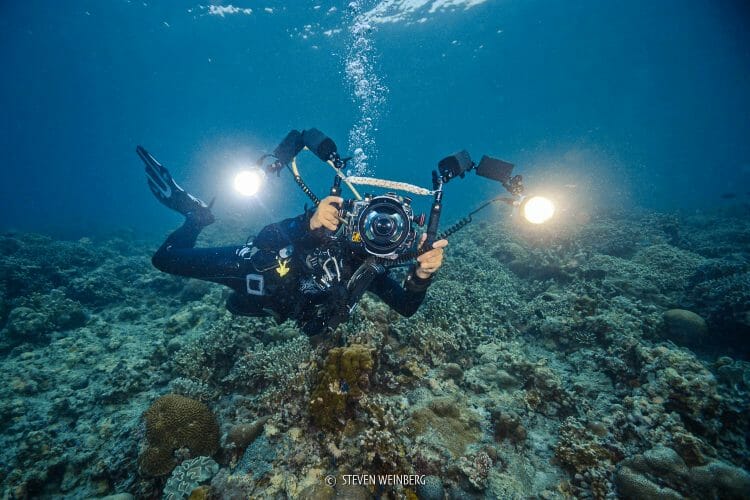
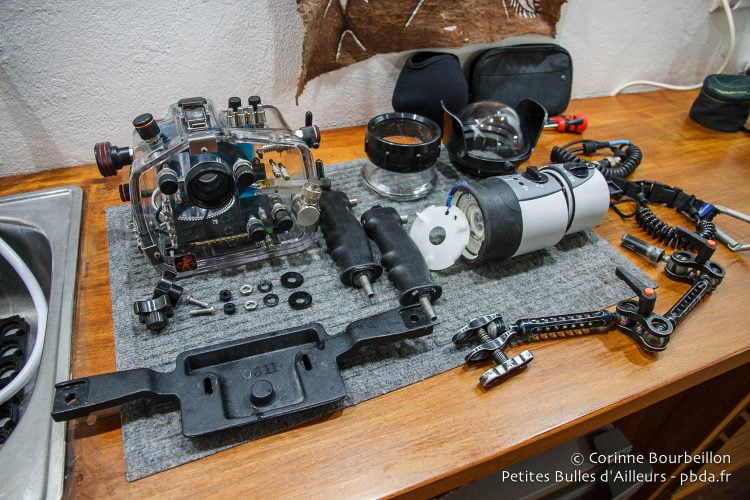
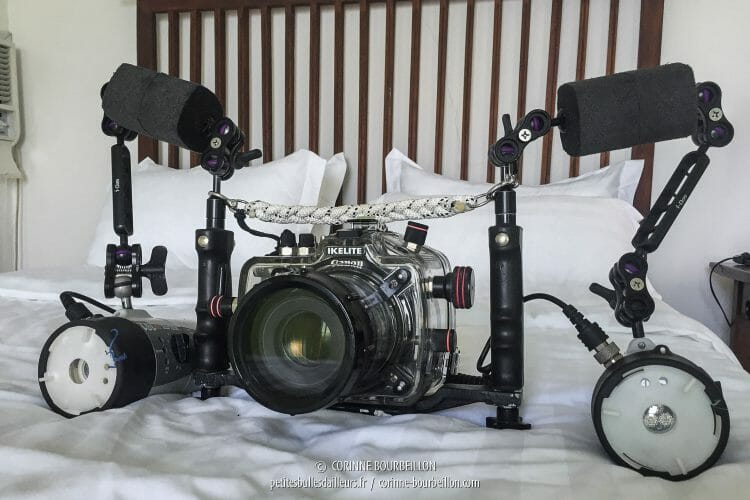
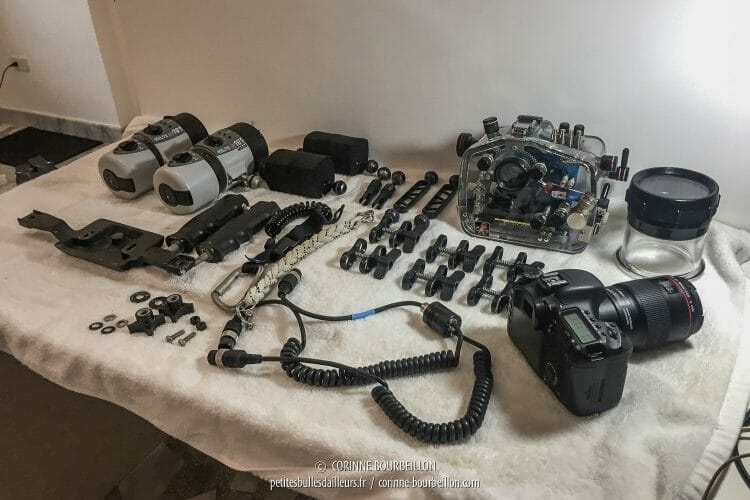
The thorny issue of "carry-on" baggage
In addition to my big wheeled luggage intended to go in the hold during air travel, I have with me a "small" cabin bag, also with wheels, bulky and convertible into a backpack, found in the store of a large Swedish furniture chain (Ikea)…
The interest is that it divides into two small bags through a zip:
- the rear part, which rolls up and is stacked to the authorized standard cabin size ;
- the front part, which turns into a mini backpack perfect for my MacBook Pro 15′ computer and my papers. All zips can be secured with small padlocks.
I divide in this "two in one" cabin baggage everything that is fragile and/or precious and that I do not want to put in the hold:
In the main part of the rolling bag: the Ikelite waterproof case for my 7D and its two windows (wide angle dome + macro window), the Canon Eos 7D and its lenses, the fragile electronic equipment (dive computer and backup hard drive), a fleece jacket for transportation (especially in Asia where the air conditioning is often pushed to the limit) and a mini emergency exchange (in case the hold luggage containing the clothes did not follow, a precaution I take since it happened to me in 2015) → Leaving on an island far from everything).
In the little detachable bag: my 15-inch MacBook Pro, my iPhone, money and papers, and my airplane survival kit (mask, earplugs, compression socks, toothbrush). I usually keep this detachable bag with me on the plane, tucked under the seat in front of me, and place the other in the overhead bin.
NB. I've had this nifty convertible carry-on bag since 2016 (before, I had a silly little backpack, which weighed a bit heavy on my shoulders, with all that bardas, in airport hallways)... I'm thrilled with my find, this new little rolling bag is perfectly suited for air travel!
The question of overweight luggage
As I said above, I only put one big rolling bag in the hold. This rolling luggage, divided in two compartments like a "wallet", contains :
- on one side, my complete diving equipment ;
- on the other side, some clothes and heavy accessories related to underwater photography that I mentioned above (the flashes and their batteries of a model authorized in the hold, the charger for these batteries, the arms of the flashes and the plate of the housing, among others).
Good thing it rolls, this bag! The whole thing easily reaches 28-29 kg... 😱
Because of the extra weight of my photo accessories (about 5 kg more), I can't stay within the 20-23 kg limit usually allowed in economy class on international flights. I therefore prefer to travel from/to France, on airlines serving Asia that allow 30 kg in the hold at no extra cost (Emirates Airlines, Malaysia Airlines, Qatar Airways, Turkish Airlines...).
Overweight fees are rarely a problem on the local airlines I often fly (Indonesian, Malaysian, Filipino): they are very low compared to Europe. You can either pre-pay them when you book online, or pay them at check-in, and they are then sometimes charged with "discount" at the customer's head (and especially the customer's, when she makes a big smile at the check-in counter and says hello in the local language)... 😉
For flights between Asian countries, I often use Air Asia which allows me to buy, at the time of booking, additional kilos beyond the basic 15kg for checked luggage, up to a total of 30kg...
Watch out for Emirates: During the stopover in Dubai, this company has the habit of checking again the weight of the hand luggage of the travelers. Employees are waiting for you with a scale, just before the access to the boarding room... Better not to exceed the 7 kg allowedFor photographers, they are very strict, the extra kilo is charged at full price (and impossible to board the plane without paying). For photographers: I advise you to take everything heavy out of your cabin bag. The easiest way is to wear your camera around your neck and to put your lenses in a multi-pocket jacket...
2010-2018: my first wheeled bag
This is the bag that faithfully accompanied me from 2010 to 2018, in all my diving trips: a 90-liter wheeled bag, light and cheap, found in a large chain of sports stores (Decathlon), in early 2010 (this Newfeel bag is no longer sold today).
Its two compartment design was very practical. My complete diving equipment was stored on one side. The clothes and part of my underwater photography bardas on the other.
I completely revised my luggage logistics starting in 2010, when I started to carry more substantial photo equipment to make underwater images. I talk about it in these articles:
→ No more backpacks, long live the wheelie bag!
→ Photo Equipment and Dive Gear
I have unapologetically given up my "backpacker" status carrying all of her stuff on my back/shoulder. It's much less exhausting to be a "rollpackeuse"... 😂
This compact, unobtrusive wheeled bag attracted much less attention than the bulky diver travel bags, which all have a prominent brand name written across the top. It lasted eight years, with 3 to 4 trips per year and was often abused!
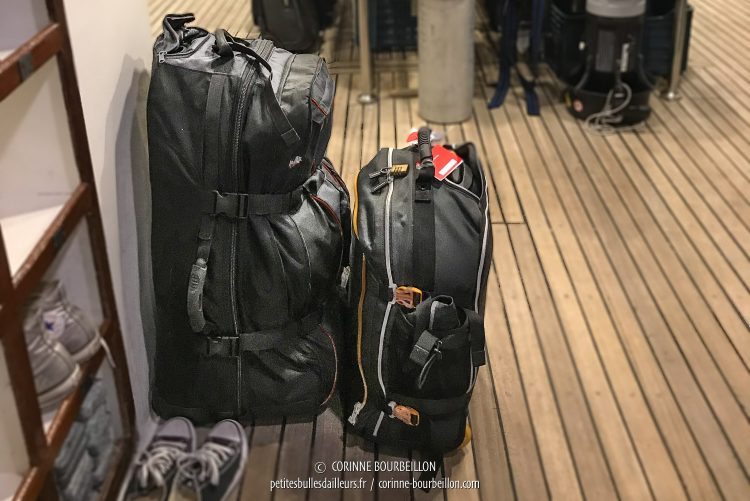
I was very happy with it, until it let go of me in May 2018 when I returned from a trip to the Philippines.
The handle ended up coming off its rail and the two corners at the bottom front were all frayed. On the other hand, the zippers still held and the whole canvas was still in good condition. Quite sturdy, so despite its very small price, a very good investment.
Until 2009: my backpacker's luggage
The picture below was my backpacking gear, before 2010. I was then a backpacker, a "backpacketeer". I had not yet invested in a waterproof case to take my SLR camera underwater (Canon Eos 7D), which today represents a whole new set of equipment to carry.
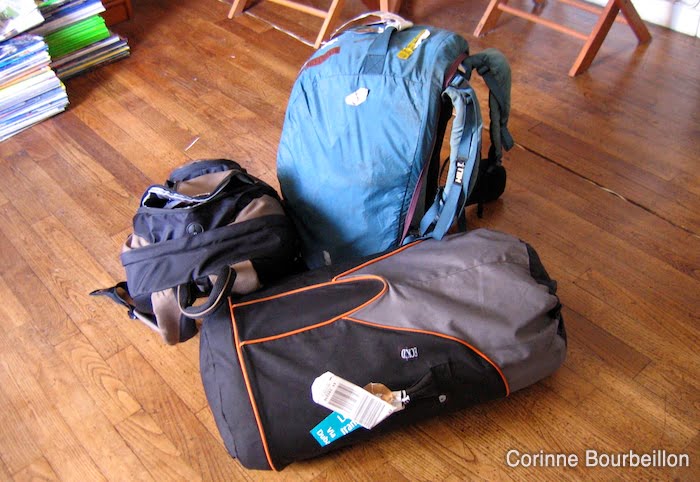
I would then travel with the following three pieces of luggage:
- 1. A big backpack (green stuff) for clothes and the rest (10-12 kg)
- 2. A sausage bag with shoulder strap for diving equipment (10-11 kg)
- 3. A small backpackMy "cabin" luggage, where I stored my compact camera of the time and its small case, the laptop and the small fragile and/or precious things (iPhone, papers, money)...
All of this was within the usual limits of economy class luggage at the time: about 20 kilos in the hold (my two big bags) + a few kilos in the cabin.
Clothes: the tropical minimum
And what else do you put in your luggage for a trip to Southeast Asia or tropical islands? As little as possible! 😎 🌴 As I've traveled around Asia, I've thus learned to pack only the essentials. I've compiled a small summary list below.
Long live summer clothes! My usual destinations have the same climate: hot and humid. I don't have to worry about buying anything: if I need something, I buy it on the spot (and it's much cheaper than in France). No problem to get flip-flops, tee-shirts or sarongs in Asia!
Clothes: tops
- some strapless tops for the "beach" places
- two T-shirts covering the shoulders and several thin long-sleeved tunics. Both to respect certain places and situations (cities, Muslim countries, temples) and as protection against mosquitoes at night. Preferably things that are easy to wash and match with any stocking.
- a small fleece jacket for all air-conditioned places that are often in "fridge" mode (plane, bus, boat, shopping malls, etc.)
Clothing: stockings
- cropped trousers
- long trousers (for travel by plane, and for places and circumstances where it is not better, as a woman, to be bare legs)
- a skirt and/or a summer dress with straps
- one or two shorts
Undergarments
- panties and bras: simple and comfortable
- in sufficient quantity for a week
At the feet
- a pair of canvas sneakers that I wear on the plane, which I use only when I have to walk a little
- a pair of flip-flops that don't weigh anything in the bag and that I have almost permanently on my feet
I'm not a trekker, so I don't bother with heavy hiking boots or socks...
My indispensable accessories
- 3 or 4 bathing suits (I'm in the water all the time, I like to change)
- 2 to 3 pareos or sarongs (one "clean", one or two others for the beach and sea outings, I often buy new ones on the spot)
- a hammock (one of these light models as found everywhere in Asia)
- Sun glasses
I do not take bath towel for a long time, it is now everywhere.
Toilet stuff
- Shampoo, conditioner, shower gel or soap, toothpaste, moisturizer, sunscreen, etc. Before, I used to take them in minimal quantities in small bottles for the arrival, because I often bought my toiletries on the spot to save weight in my luggage. Now, I use biodegradable products to pollute as little as possible and as they are not easy to find when traveling, I take the necessary quantity with me.
- Toothbrush, hairbrush, hair elastics, tweezers, razor, etc.
Girls' special: Whether you are tampons, cup or pads, it is better to think of taking your sanitary protections with you, we are not sure to find the solution that we prefer everywhere, especially tampons...
Médocs: small pharmacy for sores
My first-aid kit has been getting smaller and smaller during my travels, mostly to Asia and the Indo-Pacific archipelagos... Keep in mind that in tourist areas and big cities, there are usually medical facilities in case of a real problem.
Globally, the risk of contracting a serious illness is minimal for a Western traveler who is in good health, well nourished, and whose vaccinations are up to date. And if it happens, you will not treat yourself: you will consult a doctor on the spot or you will use the services of a travel assistance/insurance company.
So I'm happy here to give common sense advice, for small problems on the trip, not for serious situations. These tips obviously can not replace a medical opinion. But given the exorbitant price of some drugs (which often will not be used), the best is to take with you only enough to treat small disorders and small sores.
Covid-19. This article dates from before the pandemic... In addition to the basic health recommendations recalled here, if you manage to travel despite the restrictions imposed by the sanitary situation related to the coronavirus, remember to take the precautions to protect yourself and others: mask, distancing, hand washing (soap and hydroalcoholic gel)
The really useful stuff
Problems most likely to be faced: the famous tourista (traveler's diarrhea) and small wounds (bites, scratches, cuts, blisters, which heal poorly in a humid climate and can become infected).
So, what is really useful in a travel first-aid kit: it is at least an anti-diarrhea, as well as bandages sterile and a disinfectant type Betadine (be careful on all the small wounds on the feet, since we walk all the time barefoot, in flip-flops, that can get infected very easily). I have now with me also adapted waterproof bandages to protect a wound when I dive, the salt water only making the situation worse otherwise...
Possibly antibioticsIf you know that you will spend time far from any city (where you can find a doctor and/or a pharmacy). For example, I once had to find a pharmacy in a hurry between two planes in Indonesia, in order to get antibiotics for three days, in order to stop the infection of a palm blister (sic!) which had degenerated.
For small ordinary ailments, I also take a few pills ofanti-pain with paracetamolDoliprane or equivalent.
Finally, very useful for the diver that I am: some drops to treat otitis externa (caused by poorly rinsed ears after immersions). The most effective for this type of infection, among those I tested: those named Ottopain in Indonesia or Panotile in France.
Mosquitoes and malaria
The malaria (also called malaria) is an infectious disease potentially deadly, caused by parasites of the genus Plasmodium, transmitted by mosquitoes when they bite us.
Malaria does not occur everywhere in equatorial or tropical regions of the world, nor in the same country considered a malaria-endemic zone. By this I mean: there is no need to take preventive treatment when you go to Phuket, for example... For malaria-infested areas, it is obviously advisable to consult a doctor before leaving. He alone can properly inform you about the risks of contamination where you are going and how best to prevent them.
This is not a matter to be taken lightly. As many travelers on the internet rightly remind us, it only takes one bite from a mosquito carrying the parasite to be infected for life...
For me, it is rare that I take an anti-malarial treatment. I am often asked the question and I am always a little embarrassed to answer, knowing that it can influence the decision of other people. But it is a personal choice, and I assume the risk for myself, knowingly.
My decision is not a substitute for medical advice and is not a recommendation. Everyone to take responsibility with their health.
I usually stick to the simplest basic precautions, which have proven their worth: mosquito repellent, long sleeves and pants at dusk if needed, careful closure of the net around the bed if there is one and the room is not closed.
I invite you to read this excellent article published by François du blog Tourdumondiste, which explains everything very well, with serious information (sourced) and advice → Should I take malaria medication when travelling?
Malaria is not the only thing to worry about: mosquitoes can also transmit the dengue...in particular. Protecting yourself with repellent and long clothing is therefore a basic precaution in all cases.
Techno: an indispensable superfluous
Now, I admit, I'm getting a little loaded. I'm addicted to my toys! I used to travel for a long time without a computer, back when I was a real backpacker, but that's over. Back then, in order to connect to the web and keep this blog up to date during my travels, I used to spend hours in local internet cafes...
1. Laptop
The first time I decided to go with a laptop, I first opted for a light and not too expensive netbook (a laptop), the small Medion Akoya (read here → My technomade mini-computer). But from 2010, when I acquired my Canon 7D SLR camera who is doing HD videoI gave it up: this little computer was not powerful enough...
Instead, I took my old 15-inch MacBook Pro. Only, it gave me a fright when it fell out of order, with a nice black screen: it didn't like the humidity and the heat at all. It came back to life afterwards, but this machine was already starting to be obsolete at that time. Technological toys are evolving at full speed!!!
So, in January 2011, I fell for a 13 inch MacBook AirIt was one of the first generation, very light, very good. I loved it and traveled with it for many years. But in the same way, it ended up not being enough for me, with the stock of Raw photos and videos I was accumulating... Its slowness, facing new software and ever larger files, became exasperating.
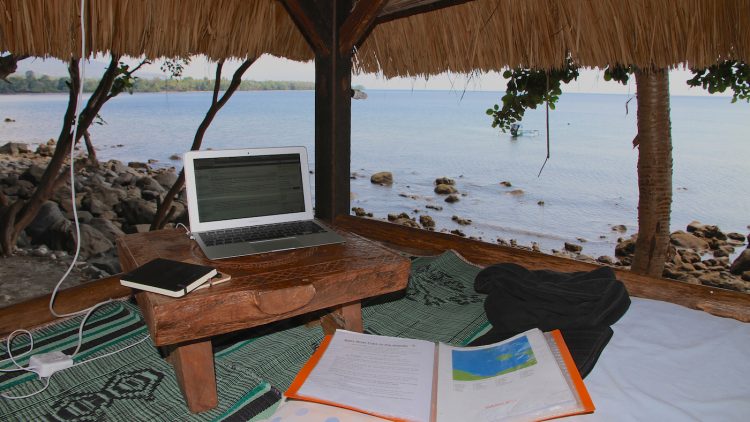
So, in June 2016, I invested in a new machine, capable of processing a lot of large files without dragging and which should be able to last several years: a MacBook Pro 15-inch Retina Display from mid-2015 (photo below).
I bought it reconditioned (these are computers that have been used in a store presentation and that have been refurbished for sale afterwards, it allows a consequent saving, compared to a new model) on the Refurb Store from the brand to the apple.
I took care to choose a model with a lot of power (16Gb of RAM + 2.5GHz Intel Core i7 processor) and storage (1TB of flash memory), in order to be able to process heavy photo and video files, and in the hope that it won't be obsolete too quickly...
With the amount of underwater pictures I make now, I can't imagine traveling without a computer. I can write my texts whenever I want, from my room or my terrace, sort my pictures as I go along on LightroomI was able to connect to the internet, either by using a wifi connection when there is one, or by using the shared connection of my iPhone in which I put a local SIM card (it's not expensive at all in Asia, very convenient to connect via the mobile network).
2. Photo and video equipment
Since January 2010, I travel with a SLR camera that also makes video, the Canon Eos 7D (nothing to do with the small digital compact Canon Powershot A95 who used to accompany me). I am very happy with it, even if it is quite heavy and cumbersome.
It has never let me down, it is robust, tolerates well the wet conditions I regularly inflict on it, and is capable of making superb images underwater.
I haven't renewed this equipment yet (it's a big budget, especially since I'd have to buy a new housing for a new camera, these things are not interchangeable, and a housing costs roughly the same price as the body 😱 ).
Before, I also had a compact camera as a backup, for terrestrial pictures, but the iPhone has now become my second camera. In just a few years, the quality of the smartphone sensor has become excellent.
In 2019, I acquired a mini-SLR as a secondary camera for terrestrial photography, the Canon Eos 250D. Extremely light, cheap, it is considered a "beginners" SLR. But it seems to me to have the right technology to be a practical and versatile camera for travel. I will talk about it when I have tested it more in the field. It was becoming complicated for me to take the 7D out of the housing after each dive when I needed it for pictures I didn't want to take with the iPhone.
For the 7D, I carry several 32GB and 16GB memory cards, a spare battery and its charger. For the 250D, I have two SD memory cards, one 8GB inherited from an old camera, one 32GB with a fast flow, adapted to the video, as well as a spare battery and the charger.
My goals (see here → Photo and diving: my equipment) are interchangeable on both housings.
Finally, I also have a 500GB SSD portable hard drive to back up photos and videos (I unload and store the originals on my MacBook Pro).
For underwater shooting, as I explained above, I also carry the Ikelite housing for my SLR (as well as its accessories: the flashes and their charger, the flash arms, the cords, the stage, the portholes...).
3. iPhone
I was also talking about it above. I currently have the iPhone X and it's really my second camera now. It allows me to make images without attracting attentionIn Asia, everyone takes out his smartphone to take pictures! We always have it at hand, really practical.
For all communications (phone, SMS, internet), I put a local SIM the time of the trip, it allows to have access to internet in 3G and 4G when there is network and it avoids the roaming fees. It serves as a "modem" to the computer via connection sharing, when there is no wifi available and I only have the local telephone network to connect to the internet.
NB. In this month of June 2019, just discovered with spite that the new iPhone XR and XS allow recently the use of e-SIMBut not the iPhone X I have... Too bad for me, the e-SIM is virtual, so you can keep your usual number associated to the iPhone without a physical SIM. So you can slip a second physical SIM card in the device, for example a local SIM, without losing the first number... The perfect kind of thing for me!
4. Cables
In modest accommodations, it is rare to have more than one electrical outlet. And it is sometimes installed in strange places, in height, or near the door, or in an inaccessible corner behind the bed... So I take a strip, to connect all this little world more easily. I check before leaving the type of taking the country to take the adapter (but if you forget, you can find it on site).
I also have a USB key, a memory card reader to download my photos and of course the cable and plug for iPhone.

